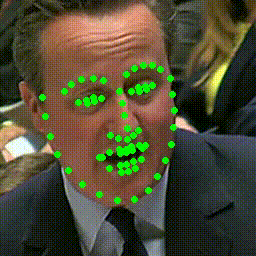Pingchuan Ma, Brais Martinez, Stavros Petridis, Maja Pantic.
2021-06-09: We have released our official training code, see here.
2020-12-08: We have released the audio-only model which achieves the testing accuracy of 98.5% on LRW.
- Introduction
- Preprocessing
- How to install the environment
- How to prepare the dataset
- How to train
- How to test
- How to extract embeddings
This is the respository of Towards Practical Lipreading with Distilled and Efficient Models and Lipreading using Temporal Convolutional Networks. In this repository, we provide training code, pre-trained models, network settings for end-to-end visual speech recognition (lipreading). We trained our model on LRW. The network architecture is based on 3D convolution, ResNet-18 plus MS-TCN.
By using this repository, you can achieve a performance of 87.9% on the LRW dataset. This reporsitory also provides a script for feature extraction.
As described in our paper, each video sequence from the LRW dataset is processed by 1) doing face detection and face alignment, 2) aligning each frame to a reference mean face shape 3) cropping a fixed 96 × 96 pixels wide ROI from the aligned face image so that the mouth region is always roughly centered on the image crop 4) transform the cropped image to gray level.
You can run the pre-processing script provided in the preprocessing folder to extract the mouth ROIs.
 |  |  |  |
| 0. Original | 1. Detection | 2. Transformation | 3. Mouth ROIs |
- Clone the repository into a directory. We refer to that directory as
TCN_LIPREADING_ROOT.
git clone --recursive https://github.com/mpc001/Lipreading_using_Temporal_Convolutional_Networks.git- Install all required packages.
pip install -r requirements.txt-
Download our pre-computed landmarks from GoogleDrive or BaiduDrive (key: kumy) and unzip them to
$TCN_LIPREADING_ROOT/landmarks/folder. -
Pre-process mouth ROIs using the script crop_mouth_from_video.py in the preprocessing folder and save them to
$TCN_LIPREADING_ROOT/datasets/visual_data/. -
Pre-process audio waveforms using the script extract_audio_from_video.py in the preprocessing folder and save them to
$TCN_LIPREADING_ROOT/datasets/audio_data/. -
Download a pre-trained model from Model Zoo and put the model into the
$TCN_LIPREADING_ROOT/models/folder.
- Train a visual-only model.
CUDA_VISIBLE_DEVICES=0 python main.py --config-path <MODEL-JSON-PATH> \
--annonation-direc <ANNONATION-DIRECTORY> \
--data-dir <MOUTH-ROIS-DIRECTORY>- Train an audio-only model.
CUDA_VISIBLE_DEVICES=0 python main.py --modality raw_audio \
--config-path <MODEL-JSON-PATH> \
--annonation-direc <ANNONATION-DIRECTORY> \
--data-dir <AUDIO-WAVEFORMS-DIRECTORY>We call the original LRW directory that includes timestamps (.txt) as <ANNONATION-DIRECTORY>.
- Resume from last checkpoint.
You can pass the checkpoint path (.pth.tar) <CHECKPOINT-PATH> to the variable argument --model-path, and specify the --init-epoch to 1 to resume training.
- Evaluate the visual-only performance (lipreading).
CUDA_VISIBLE_DEVICES=0 python main.py --config-path <MODEL-JSON-PATH> \
--model-path <MODEL-PATH> \
--data-dir <MOUTH-ROIS-DIRECTORY> \
--test- Evaluate the audio-only performance.
CUDA_VISIBLE_DEVICES=0 python main.py --modality raw_audio \
--config-path <MODEL-JSON-PATH> \
--model-path <MODEL-PATH> \
--data-dir <AUDIO-WAVEFORMS-DIRECTORY>
--testWe assume you have cropped the mouth patches and put them into <MOUTH-PATCH-PATH>. The mouth embeddings will be saved in the .npz format
- To extract 512-D feature embeddings from the top of ResNet-18:
CUDA_VISIBLE_DEVICES=0 python main.py --extract-feats \
--config-path <MODEL-JSON-PATH> \
--model-path <MODEL-PATH> \
--mouth-patch-path <MOUTH-PATCH-PATH> \
--mouth-embedding-out-path <OUTPUT-PATH>We plan to include more models in the future. We use a sequence of 29-frames with a size of 88 by 88 pixels to compute the FLOPs.
| Architecture | Acc. | FLOPs (G) | url | size (MB) |
|---|---|---|---|---|
| Audio-only | ||||
| resnet18_mstcn(adamw) | 98.9 | 3.72 | GoogleDrive or BaiduDrive (key: xt66) | 111 |
| resnet18_mstcn | 98.5 | 3.72 | GoogleDrive or BaiduDrive (key: 3n25) | 111 |
| Visual-only | ||||
| resnet18_mstcn(adamw_s3) | 87.9 | 10.31 | GoogleDrive or BaiduDrive (key: j5tw) | 139 |
| resnet18_mstcn | 85.5 | 10.31 | GoogleDrive or BaiduDrive (key: um1q) | 139 |
| snv1x_tcn2x | 84.6 | 1.31 | GoogleDrive or BaiduDrive (key: f79d) | 35 |
| snv1x_dsmstcn3x | 85.3 | 1.26 | GoogleDrive or BaiduDrive (key: 86s4) | 36 |
| snv1x_tcn1x | 82.7 | 1.12 | GoogleDrive or BaiduDrive (key: 3caa) | 15 |
| snv05x_tcn2x | 82.5 | 1.02 | GoogleDrive or BaiduDrive (key: ej9e) | 32 |
| snv05x_tcn1x | 79.9 | 0.58 | GoogleDrive or BaiduDrive (key: devg) | 11 |
If you find this code useful in your research, please consider to cite the following papers:
@INPROCEEDINGS{ma2020towards,
author={Ma, Pingchuan and Martinez, Brais and Petridis, Stavros and Pantic, Maja},
booktitle={IEEE International Conference on Acoustics, Speech and Signal Processing (ICASSP)},
title={Towards Practical Lipreading with Distilled and Efficient Models},
year={2021},
pages={7608-7612},
doi={10.1109/ICASSP39728.2021.9415063}
}
@INPROCEEDINGS{martinez2020lipreading,
author={Martinez, Brais and Ma, Pingchuan and Petridis, Stavros and Pantic, Maja},
booktitle={IEEE International Conference on Acoustics, Speech and Signal Processing (ICASSP)},
title={Lipreading Using Temporal Convolutional Networks},
year={2020},
pages={6319-6323},
doi={10.1109/ICASSP40776.2020.9053841}
}It is noted that the code can only be used for comparative or benchmarking purposes. Users can only use code supplied under a License for non-commercial purposes.
[Pingchuan Ma](pingchuan.ma16[at]imperial.ac.uk)

